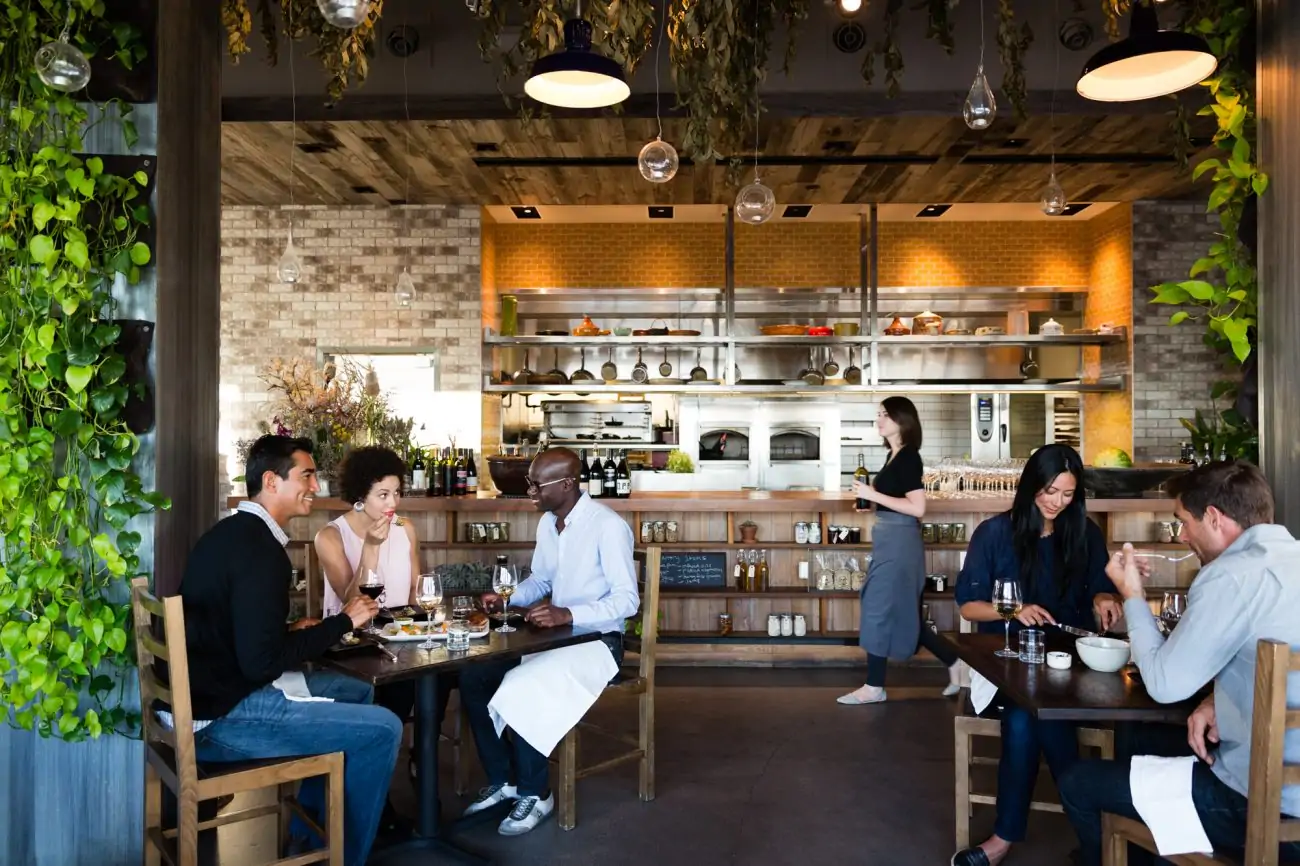Every expert I’ve spoken to on this subject agrees: Negotiating a lease is the number one place where restaurateurs go wrong. First and foremost, never sign a lease contract without having your attorney and either your designer, architect, or general contractor review it.
But before we dive into how each of these people needs to participate in your lease negotiation process, let’s talk about how you should go about finding them in the first place and when you’ll need to get them involved.
The smart time to bring people on board is right at the very beginning. Not having the right partners in place from the outset can cost you. “A lot of restaurateurs will sign a lease that forces them into a financial corner and they have to pay for a lot more and put in a lot more infrastructure than they initially anticipated,” says Tanya Spaulding, principal at Shea, Inc. Here are three partners you’ll want on your side before leasing a restaurant space.
Attorney
From the start, hopefully, you will have at least consulted with an attorney and possibly already retained one. If you are happy with the relationship you’ve established and the attorney has experience with commercial leases, stay with the same person because they are already familiar with your concept. If you’re still on the hunt, ask your peers who they use and what their experience has been. Strong referrals and a deep background with restaurants similar to yours are good places to start.
Designer & architect
A designer is traditionally responsible for laying out a space and choosing finishes, furniture, and other interior details that make up the overall aesthetic of a space. An architect is a licensed professional who will draw up your construction documents and has the power to sign them and submit them for government approval.
Many firms have both interior designers and architects on staff in order to create a seamless process, though not all firms do. Spaulding stresses that your architect and interior designer should have a good relationship. If they’re not from the same firm, make sure they’ve worked together before to produce beautiful, successful restaurants.
When seeking a designer, find a company that has worked on restaurants you love—but this can’t be the only filter. Spaulding warns against designers that lure you in with stunning portfolios and enticing renderings of your own concept before ever having a conversation about what your budget looks like. Don’t let yourself fall in love with images of restaurants that cost $1,000 per square foot to build out. Always consider the money factor.
A critical question to ask, Spaulding says, is, “What kind of business partner will you be to me? You need to bring on an architect and a designer at the beginning that are budget-conscious and timeline-conscious.”
Another major thing to look out for is whether a designer has a “look.” If you can easily see that all of the restaurants in a designer’s portfolio have elements in common or a trademark aesthetic, consider passing. Spaulding says, “You want a designer that’s going to create your vision, not theirs.”
So how do you find a talented, business-oriented, client-focused designer? Referrals are a good bet. The restaurant industry is small, so ask around.
Interviewing the firms that you’re considering is also a really important step. Spaulding encourages clients to control that meeting so that you don’t spend the whole time being wooed by pretty pictures. “Ask them technical questions. How do they approach restaurant design? How do they deal with budgets? How do they deal with schedules?”
And of course, consider only designers who have extensive experience in restaurant design, and spend some time in other restaurants they have designed. Are the service stations functional? How has the interior held up? You’ll want to be confident your designer has practicality and the long game in mind.

General contractor
A general contractor (GC) is responsible for the overall coordination of your construction project. This includes hiring and managing subcontractors, like electricians and plumbers; creating a master schedule; applying for critical licenses and permits; and working with your design team.
Of a restaurateur’s relationship with their GC, Richard Coraine, chief development officer of Union Square Hospitality Group, says, “It’s almost like a nanny is in your family—they’re not quite family and they’re not quite your friend, but you’re letting them watch your kids. There’s a lot of vulnerability on the owner’s part.”
There are two main ways to find a general contractor. The most traditional way is to take your architectural plans, send them to three or four GCs in your area, and have them come back to you with a price quote. This approach is the more time-consuming of the two and you’ll also find a great deal of variability in what you get back.
There are so many different approaches to pricing construction jobs that it will be difficult to compare each bid on a level playing field. You never want to send partially completed plans out for pre-bidding.
Spaulding says, “Your plans won’t be detailed enough, so you’re going to have contractors that are either underbidding or overbidding to protect themselves or to get the job. Never put your contractor in a position where they can’t be upfront with you or your construction process will be wrought with costly change orders.”
The second way of selecting a general contractor is through pre-qualification. This is the method that many experts recommend because it’s a more relationship-based approach and ensures that the restaurateur finds a GC who will be a great partner to them and their architect/design team.
In the pre-qualification process, your designer will make recommendations for general contractors soon after a lease deal has been signed (though in some cases, this happens before a lease is signed). Then the restaurateur will interview them, and the GC will provide pricing based on the scope of the project. One of the biggest benefits here, Spaulding says, is that “bringing the GC on as a partner to your architect leads to an understanding of pricing at every step of the way so that both parties can keep the client’s budget in mind.”
Chris Zeman, the vice president of Zeman Construction, based in the Midwest, advises that the interview process should include more than just the GC. “You’re not hiring a general contractor, you’re hiring a few individuals that happen to work for a GC. The project manager and the superintendent will be on-site every day—that’s who makes or breaks your project. Those are the people that you need to interview so that you’re not only qualifying the company, you’re qualifying the individuals that that company would dedicate to your specific contract.”

Once your dream team is assembled, here’s what you need to know to negotiate your lease. You’ll want to review these tips carefully and, above all, really take your time to understand the fine print of the lease before you sign on the dotted line. Here are some important steps to take:
Listen to your lawyer
Your attorney will need to review your entire lease contract and will be your greatest ally in helping you negotiate terms. “Your lease is your insurance policy because if things don’t go well, you can sell your lease,” says Roberta Economidis, a partner in the law firm of Georgopoulos & Economidis, LLP. Every lease is different, but these are the items that every lawyer should be looking for.
Check your renewal options
Make sure you have a long-term lease with renewal options. At a minimum, you’ll want a 10-year lease, though some operators prefer 15-year leases to show landlords that they’re really in it for the long game. Try to negotiate two five-year renewal options and make sure the terms and conditions of these options are as close as possible to the terms of your original lease deal.
Make sure you can sublease
Any lease contract that you sign must, without exception, have a sublease or assignment clause. Without it you will not have the right to sell or transfer your business, nor will you be able to sublease your space. Both the lease term and the renewal options need to be assignable; otherwise, you will be severely hindering the value of your restaurant if you put it up for sale.
Look at the liquor license details
Economidis says that she’s seeing more and more landlords asking for the first right of refusal on the liquor license in the event that you leave the space. What does this mean?
“In California, a liquor license cannot be used as security, but if this clause is in your lease, a landlord has to be offered the option to buy your liquor license at fair market value if you decide to sell. If I’m the buyer of your restaurant and I know that the landlord has the right of first refusal on the liquor license, it’s going to make purchasing your restaurant at a high price much less desirable. It can also make relocating your restaurant difficult since the license is supposed to stay with the premises,” says Economidis.
Avoid or minimize transfer premiums
As the restaurant industry continues to blossom, landlords want in on the action. Taking first right of refusal on liquor licenses is one result of this, as is the appearance of transfer premiums in restaurant leases. This means that if you sell your restaurant, your landlord will take a portion of the sale price—in some cases, as much as 50%.
Omit personal guarantees
In every document you sign, do everything you can to remove or limit personal guarantees. If you have personally guaranteed a lease, it often means you’re legally bound to pay the rent for the entire duration of the lease term—even if your business fails.
There are three things you can do here to minimize your risk and your landlord’s that are significantly less detrimental to the restaurateur than signing off on a personal guarantee:
- Limit the time on the guarantee.
- Increase the amount of the deposit.
- Ask for a rolling guarantee. If you agree to a one-year rolling guarantee, for example, this means that you are responsible for paying the next 12 months of rent at any given time.
Have your architect check the space before signing
You must have either your designer and architect or your general contractor look at any space you’re considering before signing a lease. Either party should be able to do the assessment, and many architects and GCs actually include this inspection as a normal part of their services.
Says Coraine: “In order to be a good tenant, we believe that we need to be focusing on cooking and serving food and being nice to people, not fixing problems that exist because of the building. We make sure that building owners agree to contribute whatever is needed because our view is that the building will always be theirs.”
Double and triple check “delivery of premises” terms
This section of a lease contract outlines exactly how the landlord will be turning the space over to the tenant: what the heating and cooling capacity of the building is, its electrical capacity, and gas specifications, among many other things. Tenants often don’t take the time to review this section carefully enough, and landlords often haven’t defined what they’ll be delivering clearly enough.
Zeman says that this is where a lot of critical details are hiding. “Historically speaking, most restaurant leases are a derivative of a retail lease, and a retail space is vastly different than a restaurant space. We’ve seen an overwhelming pattern of restaurant tenants signing leases that only include half the amount of electricity and half the amount of HVAC cooling that they need. All of a sudden, there’s $250k you’ll have to spend just to make it a usable restaurant space. Is that fair to the operator? In our world, we say no, especially when they are paying restaurant rent rates.”
When you’re reviewing leases with your team, assume that the terms defined are those needed to run a restaurant. The best way to ensure that you get a space equipped to handle the structural needs of your specific type of restaurant is to ask your general contractor or architect to draft a landlord work letter, defined below.
Get your landlord work letter to the landlord before signing
The landlord work letter is a document that outlines in detail what the tenant requires the landlord to provide before any lease is signed. Zeman recommends giving this letter to the landlord before you even sign a letter of intent so that no time is wasted in moving forward if the landlord isn’t willing to comply.
At Zeman Construction, Zeman says, “We tour the raw space and I write the work letter and I hand it to the operator and I tell the operator to hand it to the landlord and say, ‘This is what we would like you to deliver for us if we’re to even be interested in signing a lease for this space.’”
Find out about the “black iron”
You will hear this term from your landlord, designer, architect, and GC. Black iron is the kitchen exhaust system and it will be the most costly part of your buildout if you’re going into a space that doesn’t already have it. Don’t guesstimate—ask your experts for an estimate of buildout cost for any space you’re seriously considering. Every site will be different, and this expense can vary by hundreds of thousands of dollars.
Sketch out your restaurant for this specific space
It’s important to have your designer give you a rough layout of what your concept will look like in a space before signing anything. If you’ve thought enough about your concept to write a business plan, pitch it to investors, and look into leasing a restaurant space, there’s no question that you have at least some idea of how you want it to be laid out. It doesn’t have to be a detailed design rendering, just a rough sketch. For clients that I’ve worked with, this exercise has been the difference between signing a lease for a space that wasn’t properly oriented or sized to hold their vision and graciously moving on to the next potential site.
Opening a restaurant can be overwhelming. But with the right partners in your corner and these expert tips in your back pocket, you can navigate your lease negotiation process with confidence.




